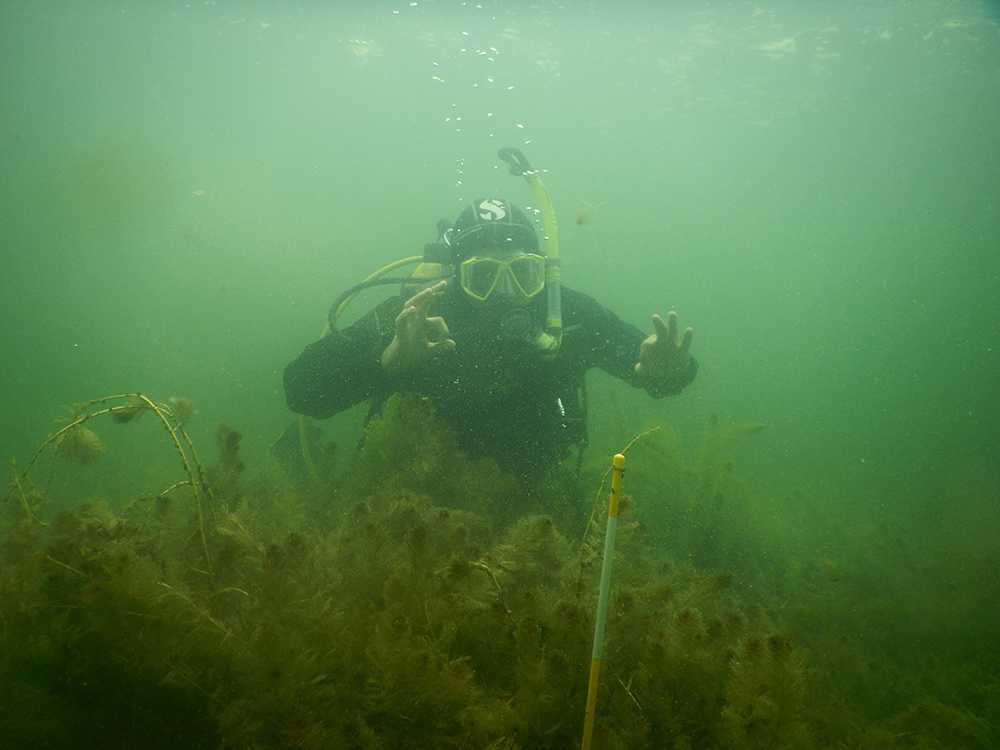By Marie Orttenburger
Watermilfoil is a prolific and notoriously hard-to-manage aquatic invasive.
Syndell Parks and her new biotech company, GenPass, LLC, based in Muskegon, Michigan, aim to make controlling it easier.
Parks uses genetics to differentiate between invasive, native and hybrid species of watermilfoil to help inform how people control the plant. Great Lakes Echo Reporter Marie Orttenburger spoke with Parks about her work.
For those interested in learning more, Parks will speak at TEDx Muskegon on October 19
Transcript
Orttenburger: Watermilfoil: an invasive aquatic plant as slimy in its machinations as it is to the touch.
It’s pillaged lakes and rivers throughout the country. It clogs dams and irrigation channels, decimates drinking water quality, destroys fish habitats and obliterates aquatic plant biodiversity. It hinders recreation too.
Parks: “I’ve been out on a kayak and gotten stuck on top of it, because it’s so thick you have to push yourself along.”
O: The trouble with watermilfoil, or more specifically Eurasian watermilfoil, is that it looks just like a native species of watermilfoil — one that we don’t want to oust. Moreover, Eurasian watermilfoil has produced a hybrid with the native species. All varieties look vaguely alike, and all respond differently to herbicides. So managing them is a bit tricky.
Syndell Parks is the owner of GenPass, LLC, a one-woman company that uses genetics to identify the species of watermilfoil her customers are trying to control.
P: “So I work with folks who work in regulatory agencies, folks who do research, folks who are actually working as environmental consultants – so they’re the ones that people who live on lakes hire to manage their lake for them. And then some of the folks are people who actually live on these lakes and are trying to decide if they need to hire someone to manage this plant.”
O: Before Parks’s customers spend money and resources on an herbicide that might not work — or one that might make things worse — they can send samples to GenPass to have them genetically tested and figure out which species they’re working with.
P: “Usually what happens is they’ll send me the plants, and I’ll send the results. And then they’ll use those results to move forward. For instance, if it’s a person living on a lake, and the results come back hybrid, then they might come back to me and say ‘hey, does this mean I need to hire a consultant’ or ‘what should I do from here.’”
O: But the answers to those questions aren’t as black and white as species identification is.
P: “Knowing what it is only answers one part of the question, they want to know how it’s gonna respond. So right now, the science isn’t there yet. We can’t tell them how it’s going to respond because we haven’t figured out the basis for the response yet.”
O: While she can guide her customers in figuring out their next move, the science hasn’t yet determined what watermilfoil’s genetic makeup reveals about its capacity for resistance. A tailored strategy to oust the plant doesn’t exist.
P: “So what I’ve been trying to figure out is how can I be involved in trying to help push that research forward and making it happen faster. Two things we’re trying to figure out is one, what works right now, and the second is what is the basis for this resistance. Because if we understand where this resistance is coming from, it gives us an idea of how to combat it.”
O: So far, that means sending samples to Montana State University, where Parks’s former graduate school adviser, Ryan Thum, teaches and does research on watermilfoil. GenPass itself is actually built from research Thum did while he was teaching at Grand Valley State University in Michigan.
O: There’s potential for Parks to apply similar methods to other invasive species, but developing the appropriate science is costly. Parks said she’d have to see substantial enough demand to support the research it requires.
P: “Working with a new species is gonna require a lot of development to figure out if it’s possible to do it with genetics, and then how to do it in a way that’s streamlined enough to do it for a profit. At the moment, I’ve not found other species yet that are a viable option for something like this. A lot of those would probably have to go through a university first.”
O: GenPass, LLC is based Grand Valley State University’s Annis Water Resources Institute in Muskegon, Michigan. Muskegon Innovation Hub provides Parks with an office and business help.





Orttenburger says in the first paragraph of the transcript that… “(Eurasian Watermilfoil) destroys fish habitat”. You need to be very careful when making claims like this. There’s no study or scientific evidence to support the notion that it destroys fish habitat. EWM, like all plants, native or invasive, >IS< fish habitat. In fact, when present, it's often the preferred plant species fish use for cover because it grows much taller than most native species. EWM can be rightly accused of a lot of negative traits, but destroying fish habitat is not one of them.